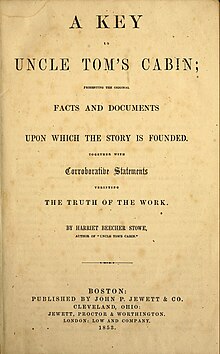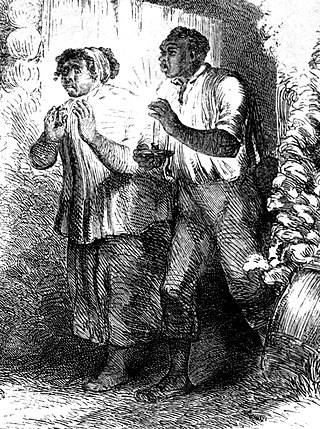
Uncle Tom is the title character of Harriet Beecher Stowe's 1852 novel Uncle Tom's Cabin. The character was seen in the Victorian era as a ground-breaking literary attack against the dehumanization of slaves. Tom is a deeply religious Christian preacher to his fellow slaves who uses nonresistance, but who is willingly flogged to death rather than violate the plantation's code of silence by informing against the route being used by two women who have just escaped from slavery. However, the character also came to be criticized for allegedly being inexplicably kind to white slaveowners, especially based on his portrayal in pro-compassion dramatizations. This led to the use of Uncle Tom – sometimes shortened to just a Tom – as a derogatory epithet for an exceedingly subservient person or house negro, particularly one accepting and uncritical of their own lower-class status.

Uncle Tom's Cabin; or, Life Among the Lowly is an anti-slavery novel by American author Harriet Beecher Stowe. Published in two volumes in 1852, the novel had a profound effect on attitudes toward African Americans and slavery in the U.S., and is said to have "helped lay the groundwork for the [American] Civil War".

Harriet Elisabeth Beecher Stowe was an American author and abolitionist. She came from the religious Beecher family and wrote the popular novel Uncle Tom's Cabin (1852), which depicts the harsh conditions experienced by enslaved African Americans. The book reached an audience of millions as a novel and play, and became influential in the United States and in Great Britain, energizing anti-slavery forces in the American North, while provoking widespread anger in the South. Stowe wrote 30 books, including novels, three travel memoirs, and collections of articles and letters. She was influential both for her writings as well as for her public stances and debates on social issues of the day.

Dred: A Tale of the Great Dismal Swamp is the second popular novel from American author Harriet Beecher Stowe. It was first published in two volumes by Phillips, Sampson and Company in 1856. Although it enjoyed better initial sales than her previous, and more famous, novel Uncle Tom's Cabin, it was ultimately less popular. Dred was of a more documentary nature whereas Uncle Tom's Cabin had much stronger characters.

John Van Zandt was an American abolitionist who aided the Underground Railroad resistance movement in Ohio after he had been a slaveholder in Kentucky. Sued for monetary damages by a slaveholder whose escaped slaves he had aided, he was a party to Jones v. Van Zandt (1847), a case by which abolitionists intended to challenge the constitutionality of slavery. The US Supreme Court decided the case against Van Zandt and upheld the right of the US Congress and the obligation of the US government to protect slavery, as it was established under the US Constitution. Van Zandt was ruined financially by the decision and died later that year.

Anti-Tom literature consists of the 19th century pro-slavery novels and other literary works written in response to Harriet Beecher Stowe's Uncle Tom's Cabin. Also called plantation literature, these writings were generally written by authors from the Southern United States. Books in the genre attempted to show that slavery was beneficial to African Americans and that the evils of slavery, as depicted in Stowe's book, were overblown and incorrect.

Aunt Phillis's Cabin; or, Southern Life as It Is by Mary Henderson Eastman is a plantation fiction novel, and is perhaps the most read anti-Tom novel in American literature. It was published by Lippincott, Grambo & Co. of Philadelphia in 1852 as a response to Harriet Beecher Stowe's Uncle Tom's Cabin, published earlier that year. The novel sold 20,000–30,000 copies, far fewer than Stowe's novel, but still a strong commercial success and bestseller. Based on her growing up in Warrenton, Virginia, of an elite planter family, Eastman portrays plantation owners and slaves as mutually respectful, kind, and happy beings.

The Planter's Northern Bride is an 1854 novel written by Caroline Lee Hentz, in response to the publication of Uncle Tom's Cabin by Harriet Beecher Stowe in 1852.

Tom show is a general term for any play or musical based on the 1852 novel Uncle Tom's Cabin by Harriet Beecher Stowe. The novel attempts to depict the harsh reality of slavery. Due to the weak copyright laws at the time, a number of unauthorized plays based on the novel were staged for decades, many of them mocking the novel's social message, and leading to the pejorative term "Uncle Tom".

Calvin Ellis Stowe was an American Biblical scholar who helped spread public education in the United States. Over his career, he was a professor of languages and Biblical and sacred literature at Andover Theological Seminary, Dartmouth College, Lane Theological Seminary, and Bowdoin College. He was the husband and literary agent of Harriet Beecher Stowe, author of the best-seller Uncle Tom's Cabin.
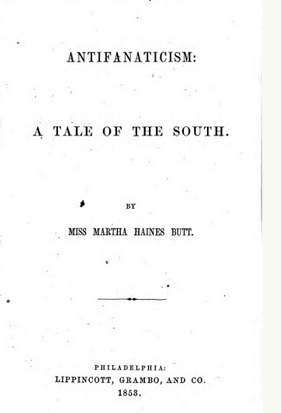
Antifanaticism: A Tale of the South is an 1853 plantation fiction novel by Martha Haines Butt.

Little Eva: The Flower of the South is an Anti-Tom children's book by American writer Philip J. Cozans. Although its publication date is unknown, scholars estimated the release was either in the 1850s or early 1860s. The book follows Little Eva, the daughter of a wealthy Alabama planter. She is characterized through her kindness toward slaves as she reads the Bible to them and teaches the alphabet to slave children. On her ninth birthday, Little Eva nearly drowns, but is rescued by a slave named Sam. Her parents free Sam who decides to remain with the family because he loves them.

The Black Gauntlet: A Tale of Plantation Life in South Carolina is an anti-Tom novel written in 1860 by Mary Howard Schoolcraft, published under her married name of Mrs. Henry Rowe Schoolcraft.

Life at the South; or, "Uncle Tom's Cabin" As It Is is an 1852 plantation fiction novel written by William L.G. Smith.

The Ebony Idol is a plantation literature novel by G. M. Flanders, first published in 1860. It is one of several pro-slavery novels written in the Southern United States in response to the 1852 abolitionist novel Uncle Tom's Cabin by Harriet Beecher Stowe.
"Uncle Tom's Cabin" Contrasted with Buckingham Hall, the Planter's Home is an 1852 novel by Robert Criswell, combining elements of Anti-Tom literature and romantic fiction.
John Punchard Jewett (1814–1884) was a Boston publisher, best known for first publishing Uncle Tom's Cabin in book form in 1852. Jewett was a brother of librarian Charles Coffin Jewett.
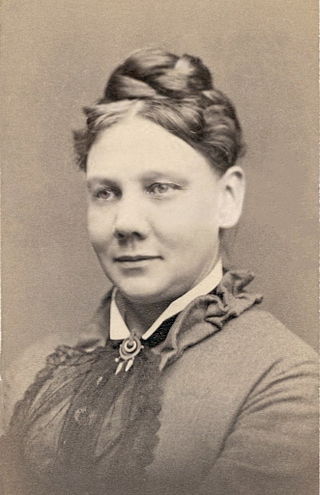
Mary Henderson Eastman was an American historian and novelist who is noted for her works about Native American life. She was also an advocate of slavery in the United States. In response to Harriet Beecher Stowe's anti-slavery Uncle Tom's Cabin, Eastman defended Southern slaveholding society by writing Aunt Phillis's Cabin: or, Southern Life As It Is (1852), which earned her considerable fame. She was the wife of the American illustrator and army officer Seth Eastman.
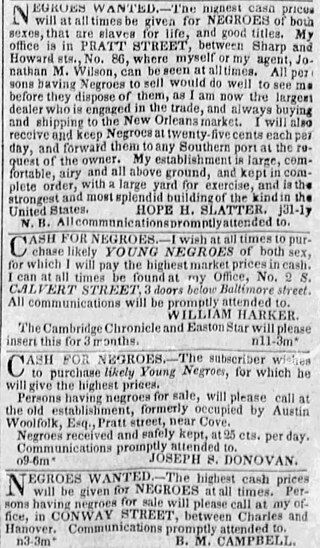
William Harker was a 19th-century American slave trader, known for his extensive career spanning over two decades. Operating primarily in Maryland, Harker played a significant role in the domestic slave trade, actively engaging in the buying and selling of enslaved African Americans from 1835 to 1859. His longevity in the trade was notable during a time when many slave traders came and went.

John W. Lindsey was a slave trader based in Montgomery, Alabama, United States in the 1840s and 1850s.
